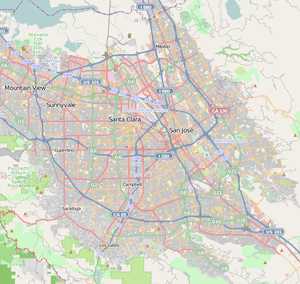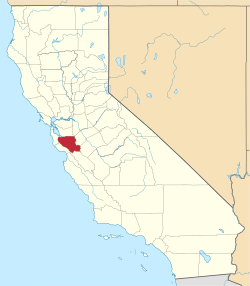Cambrian Park, California
Cambrian Park is a neighborhood and census-designated place in San Jose, California, in West San Jose. Cambrian Park was never incorporated as a town (although there were efforts to do so in the early 1960s), and much of the neighborhood is now part of the incorporated city of San Jose.
Cambrian Park | |
|---|---|
Neighborhood of San Jose Census Designated Place | |
 Location of Cambrian Park in Santa Clara County, California. | |
 Cambrian Park Location within San Jose and Silicon Valley | |
| Coordinates: 37°15′20″N 121°55′44″W | |
| Country | |
| State | |
| County | Santa Clara |
| Area | |
| • Total | 0.596 sq mi (1.544 km2) |
| • Land | 0.596 sq mi (1.544 km2) |
| • Water | 0 sq mi (0 km2) 0% |
| Elevation | 236 ft (72 m) |
| Population (2010) | |
| • Total | 3,282 |
| • Density | 5,500/sq mi (2,100/km2) |
| Time zone | UTC-8 (Pacific (PST)) |
| • Summer (DST) | UTC-7 (PDT) |
| Area code(s) | 408 |
| FIPS code | 06-10088 |
History
.jpg)
The name "Cambrian Park" was used regularly since the 1950s by the then San Jose Mercury and San Jose News newspapers (now The San Jose Mercury News) to refer to a portion of the Union school and Cambrian school areas, the latter school named in the 1870s by ranch hand David Lewis of the Jeremiah D. Casey Ranch for Cambria, the Latinized name for Wales (Welsh, Cymru), the country of Lewis's birth. Due to the relative isolation of adjacent population centers within then rural Santa Clara County, place names and later, municipalities, were often defined by their public school service boundaries. These indistinct boundaries persisted until WWII, after which a rapidly expanding population and demand for municipal services resulted in more precise boundaries being established. The Cambrian Park area continues to be recognized as a distinct, partly unincorporated neighborhood bordering the cities of San Jose and Campbell and the town of Los Gatos.[3]
We and Our Neighbors women's club was established in the adjacent Union School District area in 1892, "...to promote social ties, intellectual and cultural pursuits, charitable deeds, and recreation for the farm families of the neighborhood." Their clubhouse, built in 1910, is a San Jose Historic Landmark and appears in the National Register of Historic Places.[4]
The commerce center for the Cambrian Park area has always been the Cambrian Park Plaza. Located at the crossroads of Camden and Union Avenues, the center was originally built in 1953. Today the center maintains the country charm and construction style, across over 170,000 square feet of stores. Through the years, the center has housed a mix of local shops and national brands. The iconic colorful carousel atop the center sign is currently under evaluation for designation as a historical landmark. This is of particular interest in the community as the center was sold for the first time ever in 2015, to Texas-based Weingarten Realty.[5]

Geography
Cambrian Park is located at 37°15′20″N 121°55′44″W (37.255593, −121.928915).[6]
According to the United States Census Bureau, the CDP had a total area of 0.6 square miles (1.6 km2), all of it land.
Not all of the general area today considered "Cambrian Park" lies within San Jose's city limits. A large swath of the neighborhood was annexed by the City of Campbell in 2012, under an agreement with the City of San Jose.[7][8]
Demographics
These figures do not include any part of Cambrian Park which has been incorporated into San Jose at the time of the census.
2010
At the 2010 census Cambrian Park had a population of 3,282. The population density was 5,503.8 people per square mile (2,125.0/km²). The racial makeup of Cambrian Park was 2,598 (79.2%) White, 26 (0.8%) African American, 29 (0.9%) Native American, 221 (6.7%) Asian, 19 (0.6%) Pacific Islander, 190 (5.8%) from other races, and 199 (6.1%) from two or more races. Hispanic or Latino of any race were 591 people (18.0%).[9]
The census reported that 3,268 people (99.6% of the population) lived in households, 3 (0.1%) lived in non-institutionalized group quarters, and 11 (0.3%) were institutionalized.
There were 1,141 households, 439 (38.5%) had children under the age of 18 living in them, 670 (58.7%) were opposite-sex married couples living together, 122 (10.7%) had a female householder with no husband present, 67 (5.9%) had a male householder with no wife present. There were 57 (5.0%) unmarried opposite-sex partnerships, and 10 (0.9%) same-sex married couples or partnerships. 206 households (18.1%) were one person and 88 (7.7%) had someone living alone who was 65 or older. The average household size was 2.86. There were 859 families (75.3% of households); the average family size was 3.25.
The age distribution was 789 people (24.0%) under the age of 18, 231 people (7.0%) aged 18 to 24, 775 people (23.6%) aged 25 to 44, 1,080 people (32.9%) aged 45 to 64, and 407 people (12.4%) who were 65 or older. The median age was 42.4 years. For every 100 females, there were 101.1 males. For every 100 females age 18 and over, there were 102.2 males.
There were 1,179 housing units at an average density of 1,977.1 per square mile, of the occupied units 909 (79.7%) were owner-occupied and 232 (20.3%) were rented.The homeowner vacancy rate was 0.8%; the rental vacancy rate was 4.1%. 2,621 people (79.9% of the population) lived in owner-occupied housing units and 647 people (19.7%) lived in rental housing units.
2000
At the 2000 census there were 3,258 people, 1,127 households, and 854 families in the CDP. The population density was 2,062.2/km² (5,322.0/mi²). There were 1,143 housing units at an average density of 723.5/km² (1,867.1/mi²). The racial makeup of the CDP was 84.87% White, 0.40% African American, 1.04% Native American, 4.11% Asian, 0.21% Pacific Islander, 4.33% from other races, and 5.03% from two or more races. Hispanic or Latino of any race were 11.63%.[10]
Of the 1,127 households 35.8% had children under the age of 18 living with them, 57.8% were married couples living together, 11.7% had a female householder with no husband present, and 24.2% were non-families. 16.7% of households were one person and 6.7% were one person aged 65 or older. The average household size was 2.88 and the average family size was 3.20.
The age distribution was 25.7% under the age of 18, 7.1% from 18 to 24, 31.9% from 25 to 44, 23.5% from 45 to 64, and 11.8% 65 or older. The median age was 38 years. For every 100 females, there were 101.0 males. For every 100 females age 18 and over, there were 99.2 males.
The median household income was $80,743 and the median family income was $89,706. Males had a median income of $59,375 versus $46,700 for females. The per capita income for the CDP was $31,942. About 4.2% of families and 5.6% of the population were below the poverty line, including 3.0% of those under age 18 and 14.1% of those age 65 or over. There have been plans made in 2018 to remodel and modernize the Cambrian Park Plaza. Hundreds of townhouses and apartments, a couple of hotels, a convalescent home, a town square and a small park would mix with stores and shops at the renovated Cambrian Park Plaza shopping center, according to recently unveiled preliminary design plans.[11]
References
- U.S. Census Archived 2012-07-02 at the Wayback Machine
- U.S. Geological Survey Geographic Names Information System: Cambrian Park, California
- "History of Cambrian Area". cambriancommunitycouncil.com. Cambrian Community Council. 2009. Archived from the original on March 4, 2016. Retrieved August 12, 2015.
- "History of We and Our Neighbors". weandourneighbors.org. We and Our Neighbors. 2015. Retrieved August 12, 2015.
- "1950s Cambrian Park Plaza sold". mercurynews.com. Mercury News. 2015. Retrieved June 15, 2016.
- "US Gazetteer files: 2010, 2000, and 1990". United States Census Bureau. 2011-02-12. Retrieved 2011-04-23.
- "Why Does San Jose Have So Many Urban Islands?". KQED. 2017-02-02. Retrieved 2019-08-30.
- "It's official: Campbell council unanimously approves annexation of Cambrian 36". The Mercury News. 2012-10-04. Retrieved 2019-08-30.
- "2010 Census Interactive Population Search: CA - Cambrian Park CDP". U.S. Census Bureau. Archived from the original on July 15, 2014. Retrieved July 12, 2014.
- "U.S. Census website". United States Census Bureau. Retrieved 2008-01-31.
- "Developer plans to transform Cambrian Park Plaza into modern urban village". Retrieved 8 December 2018.
